The intelligent multifunctional laser bird repeller market is likely to grow from USD 619.4 million in 2025 to USD 1,141.0 million by 2035, reflecting a CAGR of 6.3%. Examining the market data from 2020 to 2035 reveals a consistently strong growth trajectory. Year-to-year rolling CAGR values remain close to the overall CAGR, ranging between 5.9% and 6.5%, indicating steady expansion. For example, growth from 2020 (USD 456.3 million) to 2021 (USD 485.1 million) shows a CAGR of 6.4%, while growth from 2024 (USD 582.7 million) to 2025 (USD 619.4 million) also records approximately 6.3%, demonstrating the market’s consistent momentum over time.
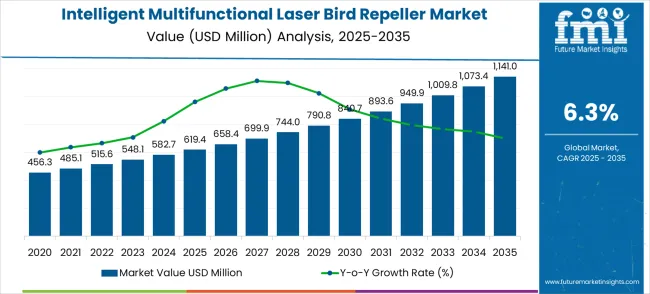
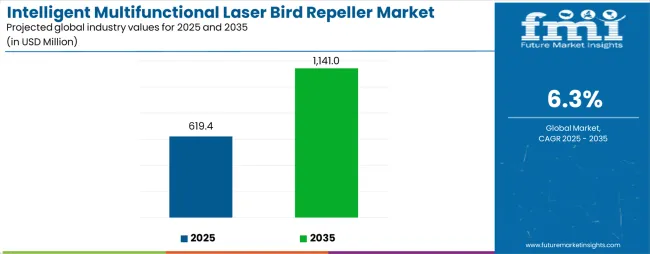
Examining multi-year rolling CAGRs highlights sustained growth over longer periods. The 3-year rolling CAGR from 2020–2023 averages approximately 6.3%, while the 5-year rolling CAGR from 2020–2025 aligns with the overall CAGR at 6.3%. Similarly, the 2025–2030 period records a 5-year CAGR of about 6.2%, and 2030–2035 growth maintains around 6.2–6.3%. These multi-year rolling rates indicate that the market does not experience abrupt spikes or sharp declines, demonstrating stability. Consistent year-to-year increases provide a solid foundation for manufacturers, investors, and end-users, enabling informed strategic planning, production scaling, and regional expansion with minimal risk of market volatility.
The rolling CAGR analysis confirms the market’s reliability and predictability, which is valuable for strategic decision-making and investment. Minor year-to-year fluctuations, typically within 0.2–0.3 percentage points, reinforce the steady nature of growth. Multi-year CAGRs demonstrate robust adoption across different sectors, including agriculture, infrastructure, and commercial properties where bird management is critical. This stability allows suppliers to optimize production, strengthen distribution networks, and maintain inventory efficiently. Over the 2020–2035 period, cumulative growth aligns closely with projections, providing a clear roadmap for revenue expansion.
| Metric | Value |
|---|---|
| Market Value (2025) | USD 619.4 million |
| Market Forecast Value (2035) | USD 1,141 million |
| Market Forecast CAGR | 6.3% |
Market expansion is being supported by the rapid increase in crop protection initiatives worldwide and the corresponding need for humane bird deterrent systems that provide superior effectiveness and environmental compatibility. Modern agricultural operations rely on consistent bird control and wildlife management quality to ensure optimal crop yields including fruit orchards, grain fields, and specialized agricultural applications. Even minor bird damage can result in substantial economic losses requiring comprehensive crop protection measures to maintain optimal agricultural productivity and operational performance.
The growing complexity of wildlife management requirements and increasing demand for automated deterrent solutions are driving demand for intelligent laser bird repeller equipment from certified manufacturers with appropriate technology capabilities and environmental expertise. Agricultural producers and facility managers are increasingly requiring documented effectiveness and system reliability to maintain crop protection quality and operational efficiency. Industry specifications and environmental standards are establishing standardized wildlife management procedures that require specialized laser technologies and trained operators.
The intelligent multifunctional laser bird repeller market is entering a transformative growth phase driven by increasing environmental awareness, rising demand for humane wildlife control, and technological advancement. As agricultural producers, airport authorities, and facility managers across both developed and emerging markets seek solutions that deliver superior effectiveness, environmental responsibility, and comprehensive bird deterrent capabilities, intelligent laser bird repellers are evolving from basic deterrent devices to sophisticated wildlife management systems integrated with AI technology, IoT connectivity, and automated monitoring capabilities.
Rising agricultural automation and smart farming adoption in Asia-Pacific, Latin America, and Middle East & Africa amplify demand, while manufacturers are advancing innovations in laser precision, target recognition, and autonomous operation features. Pathways like AI integration, multi-sensor capabilities, and cloud-enabled monitoring systems promise strong margin uplift, especially in mature markets. Geographic expansion and localization will capture volume growth, particularly where modern agriculture infrastructure is developing or wildlife management programs are expanding. Environmental protection pressures, animal welfare regulations, and sustainable farming practices provide structural market support.
The market is segmented by Product Type, application, and region. By product type, the market is divided into fixed laser bird repellent, mobile laser bird repellent, and others. Based on application, the market is categorized into aerospace industry, agriculture, fishing, electricity and communications industry, and others. Regionally, the market is divided into North America, Europe, East Asia, South Asia & Pacific, Latin America, and Middle East & Africa.
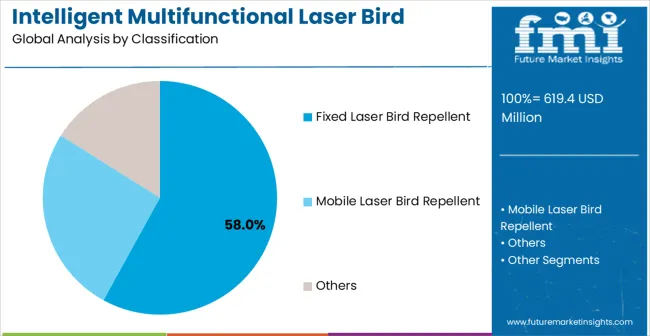
In 2025, the fixed laser bird repellent segment is projected to capture around 58% of the total market share, making it the leading product category. This dominance is largely driven by the widespread adoption of stationary laser systems that deliver reliable bird deterrence with excellent effectiveness across various agricultural and industrial applications. The fixed laser bird repellent segment is particularly favored for its ability to provide consistent deterrent coverage in permanent installation scenarios, ensuring continuous protection for agricultural facilities and critical infrastructure sites. Agricultural producers, airport authorities, power generation facilities, and specialized wildlife management operations increasingly prefer this technology, as it meets long-term bird control needs without imposing excessive maintenance requirements or complex operational protocols. The availability of well-established installation procedures, along with comprehensive monitoring options and technical support from leading manufacturers, further reinforces the segment's market position. Additionally, this product category benefits from consistent demand across regions, as it is considered a reliable solution for facilities with ongoing bird deterrent requirements. The combination of proven effectiveness, operational reliability, and cost-effectiveness makes fixed laser bird repellent systems a preferred choice, ensuring their continued popularity in the wildlife management equipment market. Advanced automation capabilities and enhanced targeting features continue to drive adoption among professional agricultural and industrial operations seeking superior bird control performance.
The agriculture segment is expected to represent 42% of intelligent multifunctional laser bird repeller demand in 2025, highlighting its position as the most significant application sector. This dominance stems from the critical importance of crop protection in agricultural operations, where effective bird deterrence is essential to maintaining harvest yields and economic viability. Agricultural applications often feature extensive coverage areas that require continuous monitoring throughout growing seasons, demanding reliable and effective bird deterrent systems. Intelligent laser bird repellers are particularly well-suited to agricultural applications due to their ability to provide humane, automated bird control effectively across large areas, even during periods of intensive bird activity. As agricultural operations expand globally and emphasize improved crop protection standards, the demand for intelligent laser bird repellers continues to rise. The segment also benefits from heightened focus on sustainable farming initiatives, where agricultural producers are increasingly prioritizing environmentally responsible bird control and automated wildlife management as key components of comprehensive crop protection programs. With agricultural operations investing in precision farming and operational efficiency enhancement, intelligent laser bird repellers provide an essential solution to maintain high-performance crop protection capabilities. The growth of smart agriculture programs, coupled with increased focus on sustainable farming practices, ensures that agriculture will remain the largest and most stable demand driver for intelligent laser bird repellers in the forecast period. Enhanced targeting capabilities and improved automation features continue to strengthen the segment's market position.
The Intelligent Multifunctional Laser Bird Repeller market is advancing steadily due to increasing environmental awareness initiatives and growing recognition of humane wildlife control technology advantages over conventional bird deterrent methods. However, the market faces challenges including higher initial equipment costs compared to traditional deterrent systems, need for specialized installation and maintenance programs for optimal operation, and varying wildlife protection regulations across different jurisdictions. Technology advancement efforts and effectiveness optimization programs continue to influence equipment development and market adoption patterns.
The growing development of advanced artificial intelligence systems is enabling more precise bird species recognition with improved targeting accuracy and reduced false activation characteristics. Enhanced AI processing technologies and optimized recognition algorithms provide superior deterrent performance while maintaining compliance with wildlife protection standards. These technologies are particularly valuable for agricultural and industrial operations that require reliable bird control systems that can support extensive coverage areas with consistent effectiveness and operational reliability.
Modern intelligent laser bird repeller manufacturers are incorporating advanced IoT connectivity features and comprehensive remote monitoring systems that enhance operational efficiency and system management effectiveness. Integration of advanced wireless communication systems and optimized cloud-based platforms enables superior monitoring results and comprehensive wildlife management capabilities. Advanced connectivity features support operation in diverse agricultural environments while meeting various deterrent requirements and monitoring specifications, including crop protection, facility management, and specialized wildlife control applications.
The continuous development of enhanced solar power technologies and intelligent energy management systems is extending operational duration while maintaining consistent deterrent performance throughout extended deployment periods. Advanced energy optimization features and intelligent power management provide sustained operation capabilities that support comprehensive wildlife management activities without performance degradation. These energy innovations are particularly valuable for agricultural operations conducting extended seasonal protection where system reliability and consistent performance are essential for effective crop protection and economic viability.
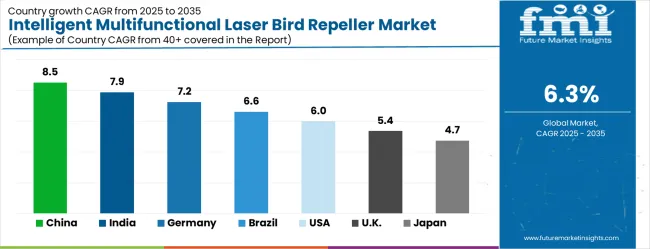
| Country | CAGR (2025 to 2035) |
|---|---|
| China | 8.5% |
| India | 7.9% |
| Germany | 7.2% |
| Brazil | 6.6% |
| United States | 6.0% |
| United Kingdom | 5.4% |
| Japan | 4.7% |
The intelligent multifunctional laser bird repeller market is growing rapidly, with China leading at an 8.5% CAGR through 2035, driven by strong agricultural modernization and increasing adoption of smart farming technologies. India follows at 7.9%, supported by rising agricultural infrastructure development and growing awareness of crop protection technologies. Germany grows steadily at 7.2%, integrating advanced wildlife management systems into its established agricultural and industrial infrastructure. Brazil records 6.6%, emphasizing agricultural modernization and sustainable farming initiatives. The United States shows solid growth at 6.0%, focusing on precision agriculture and operational efficiency enhancement. The United Kingdom demonstrates steady progress at 5.4%, maintaining established wildlife management applications. Japan records 4.7% growth, concentrating on technology advancement and precision optimization.
The report covers an in-depth analysis of 40+ countries top-performing countries are highlighted below.
Intelligent multifunctional laser bird repellers in China is projected to exhibit the highest growth rate with a CAGR of 8.5% through 2035, driven by rapid expansion of smart agriculture infrastructure and increasing demand for automated crop protection systems. The country's growing focus on agricultural modernization and expanding precision farming operations are creating significant demand for intelligent bird deterrent solutions. Major agricultural technology companies are establishing comprehensive distribution networks to support the increasing requirements of farming cooperatives and agricultural enterprises across crop production and livestock farming applications. Government agricultural development initiatives are supporting establishment of modern crop protection capabilities and advanced wildlife management systems, driving demand for sophisticated laser bird repeller technology throughout major agricultural regions and farming corridors. Agricultural modernization programs are facilitating adoption of intelligent deterrent technology that enhances crop protection effectiveness and farming efficiency standards across production networks. The Chinese government's commitment to achieving agricultural sustainability and improving food security is accelerating investments in advanced crop protection equipment. Rural development projects and smart agriculture initiatives are incorporating intelligent wildlife management systems that require sophisticated bird deterrent capabilities. Commercial farming expansion and agricultural technology advancement programs are creating additional demand for professional-grade laser bird repeller equipment that meets international effectiveness standards and operational reliability requirements.
Intelligent multifunctional laser bird repellers in India is expanding at a CAGR of 7.9%, supported by increasing agricultural development and growing awareness of modern crop protection technology benefits. The country's expanding agricultural infrastructure and rising farming productivity standards are driving demand for professional-grade bird deterrent solutions. Agricultural producers and farming cooperatives are gradually implementing advanced laser bird repeller technology to maintain crop protection standards and operational effectiveness. Agricultural sector growth and infrastructure development are creating opportunities for equipment suppliers that can support diverse farming requirements and effectiveness specifications. Professional training and technology adoption programs are building technical expertise among agricultural personnel, enabling effective utilization of laser bird repeller technology that meets crop protection standards and deterrent effectiveness requirements across agricultural regions. India's rapid agricultural development and increasing crop diversification are intensifying the need for effective wildlife management and bird deterrent capabilities. National agricultural development programs and farming modernization projects are establishing comprehensive crop protection systems that require advanced deterrent equipment. State government initiatives focusing on agricultural productivity improvement and crop loss reduction are driving procurement of modern laser bird repeller technology for farming communities. The growing emphasis on sustainable agriculture and technology adoption is supporting adoption of environmentally responsible bird deterrent systems.
Demand for intelligent multifunctional laser bird repellers in Germany is projected to grow at a CAGR of 7.2%, supported by the country's emphasis on agricultural excellence and advanced wildlife management technology adoption. German agricultural operations are implementing sophisticated laser bird repeller systems that meet stringent effectiveness requirements and environmental specifications. The market is characterized by focus on equipment precision, operational reliability, and compliance with comprehensive wildlife protection standards. Agricultural industry investments are prioritizing advanced deterrent technology that demonstrates superior effectiveness and environmental responsibility while meeting German quality and operational standards. Professional certification programs are ensuring comprehensive technical expertise among agricultural personnel, enabling specialized bird deterrent capabilities that support diverse agricultural applications and operational requirements across regional networks. Germany's commitment to maintaining the highest agricultural and environmental standards in Europe drives continuous investment in cutting-edge wildlife management technology. The country's comprehensive agricultural monitoring infrastructure requires sophisticated deterrent equipment that meets strict effectiveness and environmental compliance standards. Integration with digital farming systems and automated agricultural networks is creating demand for advanced laser bird repeller technology with enhanced connectivity capabilities. Regional agricultural cooperatives are modernizing their crop protection capabilities through procurement of state-of-the-art bird deterrent equipment that supports both seasonal and year-round agricultural operations.
Revenue from intelligent multifunctional laser bird repellers in Brazil is growing at a CAGR of 6.6%, driven by increasing agricultural development and growing recognition of advanced bird deterrent technology advantages. The country's expanding agricultural production system is gradually integrating professional-grade laser bird repeller technology to enhance crop protection capabilities and operational effectiveness. Agricultural producers and farming operations are investing in deterrent technology to address evolving crop protection requirements and wildlife management standards. Agricultural modernization is facilitating adoption of advanced deterrent technologies that support comprehensive crop protection capabilities across farming regions. Professional development programs are enhancing technical capabilities among agricultural personnel, enabling effective laser bird repeller utilization that meets evolving agricultural standards and operational requirements throughout farming networks. Brazil's extensive agricultural sector and growing export crop production are driving demand for sophisticated crop protection equipment. Federal and state government initiatives focused on improving agricultural productivity and reducing crop losses are supporting procurement of modern laser bird repeller technology. Commercial agriculture expansion and increasing farming efficiency in major agricultural areas require enhanced crop protection capabilities that can support effective farming operations. The expansion of precision agriculture services and specialized crop protection programs is creating sustained demand for reliable, effective bird deterrent equipment.
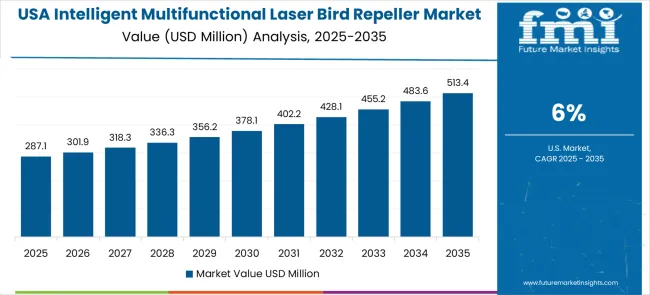
Intelligent multifunctional laser bird repellers in the U.S. is expanding at a CAGR of 6%, driven by established agricultural operations and growing emphasis on precision farming enhancement. Large agricultural producers and specialty crop operations are implementing comprehensive laser bird repeller capabilities to serve diverse crop protection requirements. The market benefits from established agricultural technology distribution networks and professional training programs that support various agricultural applications. Agricultural industry leadership is enabling standardized deterrent equipment utilization across multiple crop types, providing consistent protection effectiveness and comprehensive coverage throughout regional markets. Professional development and certification programs are building specialized technical expertise among agricultural personnel, enabling effective laser bird repeller utilization that supports evolving crop protection requirements across agricultural areas. The U.S. market is characterized by continuous technology advancement and integration with modern precision agriculture systems. Federal agricultural programs are driving procurement of sophisticated laser bird repeller equipment that meets stringent effectiveness and environmental standards. Agricultural producers and agribusiness organizations are modernizing their crop protection capabilities through adoption of advanced bird deterrent technology. The emphasis on agricultural efficiency and sustainability is supporting demand for environmentally responsible, effective deterrent system designs that enhance crop protection while maintaining wildlife welfare standards.
Demand for intelligent multifunctional laser bird repellers in the U.K. is projected to grow at a CAGR of 5.4%, supported by established agricultural sectors and growing emphasis on wildlife management capabilities. British agricultural operations and land management services are implementing laser bird repeller equipment that meets industry effectiveness standards and environmental requirements. The market benefits from established agricultural infrastructure and comprehensive training programs for agricultural professionals. Agricultural sustainability investments are prioritizing advanced deterrent equipment that supports diverse farming applications while maintaining established effectiveness and environmental standards. Professional development programs are building technical expertise among agricultural personnel, enabling specialized laser bird repeller operation capabilities that meet evolving crop protection requirements and environmental standards throughout regional agricultural networks. The United Kingdom's comprehensive agricultural strategy and commitment to environmental stewardship drives continued investment in advanced wildlife management technology. Agricultural operations across England, Wales, Scotland, and Northern Ireland are standardizing their bird deterrent equipment to ensure consistent crop protection capabilities. Integration with national agricultural monitoring systems and coordination with environmental protection programs requires sophisticated laser bird repeller technology. The emphasis on professional agricultural training and equipment certification is supporting adoption of high-quality bird deterrent systems that meet DEFRA approval standards and operational requirements.
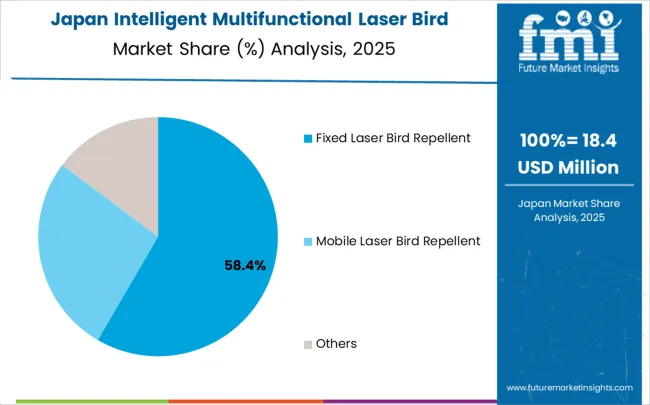
Revenue from intelligent multifunctional laser bird repellers in Japan is growing at a CAGR of 4.7%, driven by the country's focus on agricultural technology innovation and precision enhancement applications. Japanese agricultural operations are implementing advanced laser bird repeller systems that demonstrate superior effectiveness reliability and operational efficiency. The market is characterized by emphasis on technological excellence, quality assurance, and integration with established agricultural workflows. Technology industry investments are prioritizing innovative deterrent solutions that combine advanced laser technology with precision targeting while maintaining Japanese quality and reliability standards. Professional development programs are ensuring comprehensive technical expertise among agricultural personnel, enabling specialized bird deterrent capabilities that support diverse agricultural applications and operational requirements throughout metropolitan agricultural networks. Japan's commitment to maintaining the highest standards of agricultural technology and environmental responsibility drives continuous innovation in bird deterrent technology. The integration of laser bird repeller systems with intelligent agricultural infrastructure and automated farming networks requires sophisticated equipment capabilities. Agricultural operations across Japan's regions are modernizing their crop protection equipment through procurement of cutting-edge laser bird repeller technology that meets strict performance and reliability standards. The emphasis on precision agriculture and technological advancement is supporting development of next-generation bird deterrent systems with enhanced targeting and operational capabilities.
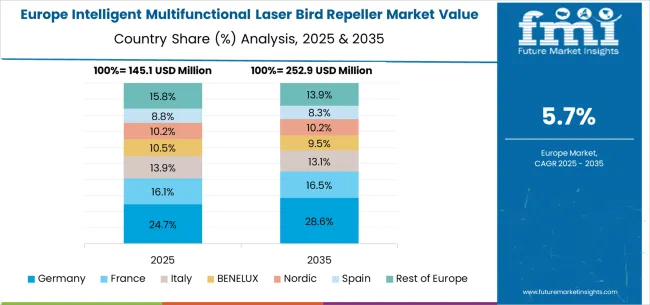
The intelligent multifunctional laser bird repeller market in Europe is anticipated to expand from USD 145.2 million in 2025 to approximately USD 238.1 million by 2035, reflecting a CAGR of 5.1% during the forecast period. Germany is set to reinforce its leading position, commanding a 31.8% share of the European market in 2025, supported by its established agricultural infrastructure, high standards for operational effectiveness, and continuous investment in advanced wildlife management technologies. The United Kingdom follows with a market share of 18.6%, benefiting from standardized agricultural procedures, professional training programs, and a robust focus on sustainable farming modernization. France is projected to capture 16.2% of the regional market, fueled by steady integration of modern crop protection equipment and enhancements in agricultural operations. Italy and Spain together represent 21.4% of total demand, as both countries advance their agricultural modernization efforts and invest in professional-grade bird deterrent solutions for farming operations. The Rest of Europe, comprising Nordic countries, BENELUX, and Eastern European markets, accounts for 12.0%, driven by regulatory convergence, infrastructure upgrading, and broader adoption of advanced intelligent laser bird repeller technology to support evolving agricultural requirements and crop protection programs.
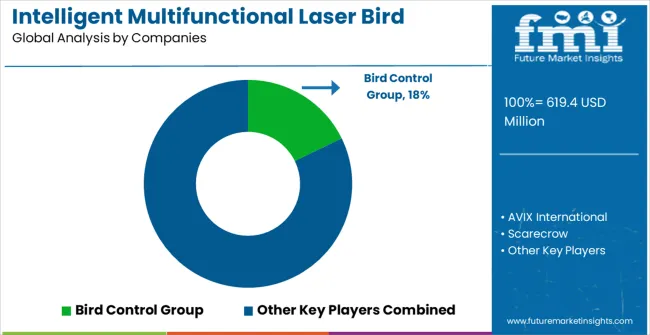
The Intelligent Multifunctional Laser Bird Repeller market is defined by competition among specialized wildlife management companies, agricultural technology manufacturers, and bird control solution providers. Companies are investing in advanced laser technology development, targeting system optimization, automation improvements, and comprehensive service capabilities to deliver effective, humane, and cost-efficient bird deterrent solutions. Strategic partnerships, technological innovation, and market expansion are central to strengthening product portfolios and market presence.
Bird Control Group offers comprehensive laser bird repeller solutions with established manufacturing expertise and professional-grade deterrent capabilities. AVIX International provides specialized bird control equipment with focus on effectiveness reliability and operational efficiency. Scarecrow delivers advanced deterrent technology solutions with emphasis on automation and user-friendly operation. Bird Gard specializes in professional wildlife management equipment with advanced laser technology integration.
Shenzhen Bird Repellent Technology offers intelligent deterrent equipment with comprehensive performance support capabilities. Telikang Technology delivers established bird control solutions with advanced laser technologies. Nanjing New Yueyang Technology provides specialized deterrent equipment with focus on precision optimization. Suzhou Derui Electric Power Technology, Linyi Zhiyu Technology, and Shenzhen Xingyuan Technology offer specialized manufacturing expertise, equipment reliability, and comprehensive product development across global and regional market segments.
| Item | Value |
|---|---|
| Quantitative Units | USD 619.4 million |
| Product Type | Fixed Laser Bird Repellent, Mobile Laser Bird Repellent |
| Application | Aerospace Industry, Agriculture, Fishing, Electricity and Communications Industry |
| Regions Covered | North America, Europe, East Asia, South Asia & Pacific, Latin America, Middle East & Africa |
| Country Covered | China, India, Germany, Brazil, United States, United Kingdom, Japan, and 40+ countries |
| Key Companies Profiled | Bird Control Group, AVIX International, Scarecrow, Bird Gard, Shenzhen Bird Repellent Technology, Telikang Technology, Nanjing New Yueyang Technology, Suzhou Derui Electric Power Technology, Linyi Zhiyu Technology, Shenzhen Xingyuan Technology |
| Additional Attributes | Dollar sales by product type and application segment, regional demand trends across major markets, competitive landscape with established wildlife management manufacturers and emerging technology providers, customer preferences for different deterrent technologies and automation options, integration with agricultural management systems and monitoring protocols, innovations in laser precision and targeting technologies, and adoption of IoT connectivity features with enhanced automation capabilities for improved agricultural workflows. |
The global intelligent multifunctional laser bird repeller market is estimated to be valued at USD 619.4 million in 2025.
The market size for the intelligent multifunctional laser bird repeller market is projected to reach USD 1,141.0 million by 2035.
The intelligent multifunctional laser bird repeller market is expected to grow at a 6.3% CAGR between 2025 and 2035.
The key product types in intelligent multifunctional laser bird repeller market are fixed laser bird repellent, mobile laser bird repellent and others.
In terms of application, aerospace industry segment to command 42% share in the intelligent multifunctional laser bird repeller market in 2025.






Our Research Products

The "Full Research Suite" delivers actionable market intel, deep dives on markets or technologies, so clients act faster, cut risk, and unlock growth.

The Leaderboard benchmarks and ranks top vendors, classifying them as Established Leaders, Leading Challengers, or Disruptors & Challengers.

Locates where complements amplify value and substitutes erode it, forecasting net impact by horizon

We deliver granular, decision-grade intel: market sizing, 5-year forecasts, pricing, adoption, usage, revenue, and operational KPIs—plus competitor tracking, regulation, and value chains—across 60 countries broadly.

Spot the shifts before they hit your P&L. We track inflection points, adoption curves, pricing moves, and ecosystem plays to show where demand is heading, why it is changing, and what to do next across high-growth markets and disruptive tech

Real-time reads of user behavior. We track shifting priorities, perceptions of today’s and next-gen services, and provider experience, then pace how fast tech moves from trial to adoption, blending buyer, consumer, and channel inputs with social signals (#WhySwitch, #UX).

Partner with our analyst team to build a custom report designed around your business priorities. From analysing market trends to assessing competitors or crafting bespoke datasets, we tailor insights to your needs.
Supplier Intelligence
Discovery & Profiling
Capacity & Footprint
Performance & Risk
Compliance & Governance
Commercial Readiness
Who Supplies Whom
Scorecards & Shortlists
Playbooks & Docs
Category Intelligence
Definition & Scope
Demand & Use Cases
Cost Drivers
Market Structure
Supply Chain Map
Trade & Policy
Operating Norms
Deliverables
Buyer Intelligence
Account Basics
Spend & Scope
Procurement Model
Vendor Requirements
Terms & Policies
Entry Strategy
Pain Points & Triggers
Outputs
Pricing Analysis
Benchmarks
Trends
Should-Cost
Indexation
Landed Cost
Commercial Terms
Deliverables
Brand Analysis
Positioning & Value Prop
Share & Presence
Customer Evidence
Go-to-Market
Digital & Reputation
Compliance & Trust
KPIs & Gaps
Outputs
Full Research Suite comprises of:
Market outlook & trends analysis
Interviews & case studies
Strategic recommendations
Vendor profiles & capabilities analysis
5-year forecasts
8 regions and 60+ country-level data splits
Market segment data splits
12 months of continuous data updates
DELIVERED AS:
PDF EXCEL ONLINE
Intelligent Touch Screen Cash Register Market Size and Share Forecast Outlook 2025 to 2035
Intelligent Road Test Instruments Market Size and Share Forecast Outlook 2025 to 2035
Intelligent Driving Technology Solution Market Size and Share Forecast Outlook 2025 to 2035
Intelligent Completion Market Size and Share Market Forecast and Outlook 2025 to 2035
Intelligent Rubber Tracks Market Size and Share Forecast Outlook 2025 to 2035
Intelligent Cervical Massager Market Size and Share Forecast Outlook 2025 to 2035
Intelligent Garment Hanging Conveyor System Market Size and Share Forecast Outlook 2025 to 2035
Intelligent Rotary Kiln Monitoring Systems Market Size and Share Forecast Outlook 2025 to 2035
Intelligent Platform Management Interface (IPMI) Market Size and Share Forecast Outlook 2025 to 2035
Intelligent Flow Meter Market Size and Share Forecast Outlook 2025 to 2035
Intelligent Lighting Control Market Size and Share Forecast Outlook 2025 to 2035
Intelligent Enterprise Data Capture Software Industry Analysis in Japan Size and Share Forecast Outlook 2025 to 2035
Intelligent Vending Machine Market Insights – Demand, Size & Industry Trends 2025–2035
Intelligent Transportation System Market Analysis - Size, Share, and Forecast Outlook 2025 to 2035
Intelligent Virtual Store Design Solution Market Size and Share Forecast Outlook 2025 to 2035
Intelligent Enterprise Data Capture Software Market Size, Growth, and Forecast 2025 to 2035
Intelligent Fencing Market Size and Share Forecast Outlook 2025 to 2035
Intelligent Packaging Market Analysis - Size, Share, and Forecast Outlook 2025 to 2035
Intelligent Enterprise Data Capture Software Market in Korea – Trends & Forecast 2025 to 2035
Intelligent Power Module Market Trends - Growth & Forecast 2025 to 2035

Thank you!
You will receive an email from our Business Development Manager. Please be sure to check your SPAM/JUNK folder too.
Chat With
MaRIA